
Stachys is a genus of plants, one of the largest in the mint family Lamiaceae. Estimates of the number of species vary from about 300, to about 450. Stachys is in the subfamily Lamioideae and its type species is Stachys sylvatica. The precise extent of the genus and its relationship to other genera in the subfamily are poorly known.

Rudbeckia fulgida, the orange coneflower or perennial coneflower, is a species of flowering plant in the family Asteraceae, native to eastern North America.

Acacia complanata, known as long-pod wattle and flat-stemmed wattle, is a perennial tree native to eastern Australia.

Hibbertia scandens, sometimes known by the common names snake vine, climbing guinea flower and golden guinea vine, is a species of flowering plant in the family Dilleniaceae and is endemic to eastern Australia. It is climber or scrambler with lance-shaped or egg-shaped leaves with the narrower end towards the base, and yellow flowers with more than thirty stamens arranged around between three and seven glabrous carpels.
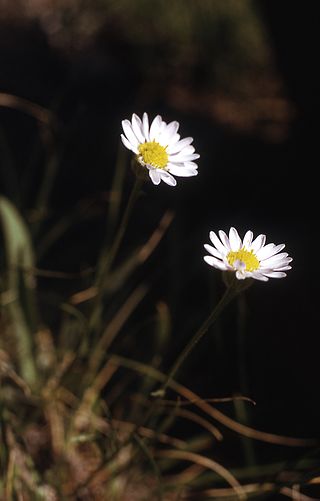
Erigeron eatonii is a North American species of flowering plants in the family Asteraceae known by the common name Eaton's fleabane.

Luina hypoleuca, the littleleaf silverback, is a species of the genus Luina and the family Asteraceae. It grows to 40 centimetres in height, its leaves 2.5–6.5 cm long and white on the underside. It flowers between June and October, with yellowish rayless flower heads about 9 millimetres long. It is found in North America on open and usually rocky places between elevations of 70–2,100 metres in British Columbia, California, Oregon, and Washington.

Rainiera is a monotypic genus of flowering plants in the daisy family, Asteraceae. The single species, Rainiera stricta(Greene) Greene, is endemic to the northwestern United States. The genus is part of the tribe Senecioneae, and appears to be most closely related to Luina, another genus of northwestern North America, in which it was once placed. Rainiera stricta is of conservation concern, with a G2G3 ranking from NatureServe, and is considered to be globally imperiled. It is known by the common name false silverback.

Achillea ageratifolia, the Balkan yarrow or Greek yarrow, is a species of flowering plant in the daisy family Asteraceae, native to Bulgaria and Greece. Growing to 20 cm (7.9 in) tall and broad, it is a compact herbaceous perennial. It is a highly variable species, with three recognized subspecies. They have erect, simple, somewhat woody based stems. The narrow grey-green foliage resembles that of a related genus Ageratum, hence the Latin specific epithet ageratifolia. The solitary, daisy-like composite flower heads are white with yellow centres and about 2–3 cm across. They appear May–July in the northern hemisphere.

Prostanthera nivea, commonly known as snowy mint-bush, is a species of flowering plant in the family Lamiaceae and is endemic to eastern Australia. It is a shrub with linear to cylindrical leaves and white flowers arranged in leaf axils near the ends of branchlets and is one of the mint-bushes that is not aromatic.
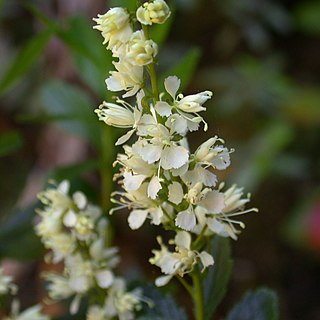
Tetracarpaea is the only genus in the flowering plant family Tetracarpaeaceae. Some taxonomists place it in the family Haloragaceae sensu lato, expanding that family from its traditional circumscription to include Penthorum and Tetracarpaea, and sometimes Aphanopetalum as well.
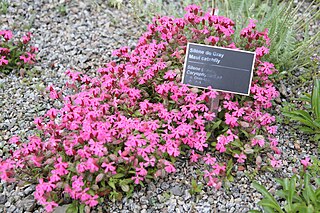
Silene grayi is a North American species of flowering plant in the family Caryophyllaceae, known by the common name Gray's catchfly.
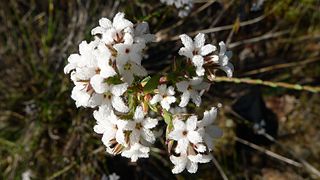
Leucopogon microphyllus is a species of flowering plant in the heath family Ericaceae and is endemic to eastern Australia. It is a bushy or spreading shrub with egg-shaped leaves, sometimes with the narrower end towards the base, and compact spikes of usually four to nine white, tube-shaped flowers.

Acacia polybotrya, commonly known the western silver wattle or the hairy feather wattle, is a shrub of the genus Acacia and the subgenus Botrycephalae. It is native to an area in New South Wales and Queensland.

Cyanothamnus nanus, commonly known as the dwarf boronia or small boronia is a plant in the citrus family Rutaceae and is endemic to eastern Australia. It is a prostrate or low spreading shrub with simple or three-part leaves and white or pale pink four-petalled flowers.

Peridiscus lucidus is a species of flowering plant, the only species in the genus Peridiscus, which is one of four genera within the family Peridiscaceae. It grows in Venezuela and northern Brazil, in evergreen, sometimes riverine forests. It was originally described by Bentham and Hooker in 1862. The taxonomic history of Peridiscus and of Peridiscaceae is complex, and has been resolved by molecular phylogenetic analysis.

Asterolasia grandiflora is a species of weak, open shrub or sub-shrub that is endemic to the southwest of Western Australia. It has oblong, elliptical or egg-shaped leaves and pink to mauve flowers arranged in umbels of about three flowers with a thick covering of star-shaped hairs on the back of the petals.
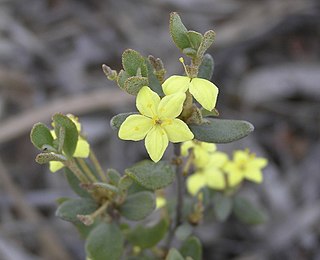
Asterolasia squamuligera, commonly known as yellow starbush, is a species of erect, woody, slender perennial shrub that is endemic to the southwest of Western Australia. It has leathery, egg-shaped leaves with the narrower end towards the base and yellow flowers arranged in umbels of five to ten with a fringe of scales on the back of the petals, and about ten stamens.

Acmispon decumbens is a species of flowering plant in the family Fabaceae, native to the western United States and north-western Mexico. It was first described by George Bentham in 1836 as Hosackia decumbens.
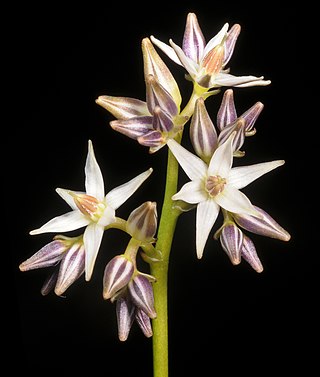
Phlebocarya filifolia is a plant in the Haemodoraceae family, native to Western Australia.

Myosotis macrantha or the Bronze Forget-Me-Not is a species of flowering plant in the family Boraginaceae, endemic to the South Island of New Zealand. Joseph Dalton Hooker described the species as Exarrhena macrantha in 1864, and Thomas Cheeseman transferred it to the genus Myosotis in 1885. Plants of this species of forget-me-not are perennial rosettes with ebracteate inflorescences and yellow to dark purple corollas with stamens that are exserted.




















